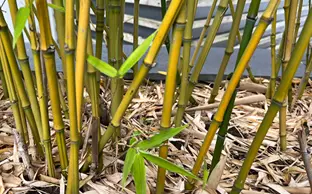Uncontrolled Bamboo: A Growing Problem for UK Homeowners
04-08-2023
Last updated 09-01-2024
Bamboos are attractive and striking architectural plants that can transform a garden. Their ease of planting and rapid formation of dense screens make them ideal for many situations where visual impact or privacy is desired. However, bamboo’s popularity in recent decades has resulted in current problems where its rapid growth and propensity to spread easily can make it an insidious nuisance.
Running bamboos are the most damaging. There are hundreds of different genera, species and varieties of bamboos that can spread many metres from their original planting locations due to their tough underground stems, called rhizomes, which ‘run’ through the ground. These cause new culms (above ground shoots/stems), to emerge through lawns, paving, decking and sometimes through buildings; all of which can cause damage and problems that can be costly to put right.
However, as the running rhizomes do not respect property boundaries, it is increasingly the case that some homeowners are suing their neighbours who allow bamboo on their properties to spread into the adjacent properties. There are numerous reports in the media that legal action is increasingly being taken against those who allow their bamboo to spread in this way. The costs and stress associated with this can be very high.
What can I use to stop bamboo from spreading?
The best method to stop bamboo from spreading is to plant it in a pot or another type of containerised bed that is effectively separated from the soil in the ground. If that’s not possible, the next best thing is to use a thick plastic bamboo root barrier to contain the roots within the ground where the plant is located. Ideally, these should be put in place at the time of planting, but it is often possible to prune the roots back to a sensible diameter close to the clump of above ground culms and then dig a membrane into place around the entire clump.
Do bamboo barriers work?
Yes. Bamboo root barriers can be very effective in stopping bamboos from spreading. However, they need to be tough and deep enough to stop the vigorous underground shoots from growing under, over or through them. Thick plastic barriers that are specifically designed for bamboo are best to use.
How deep are bamboo roots?
Unlike Japanese knotweed, the rhizomes (underground stems) of which can grow several metres deep, most bamboos are relatively shallow rooting, with rhizomes that rarely penetrate deeper than around 0.5m into the ground.
Consequently, many people with bamboo in their gardens are choosing to have it removed. However, if you really want to keep bamboo, there are methods you can employ to control it so that it doesn’t spread beyond the bounds of where it’s wanted.
Can bamboo roots be killed?
The roots of bamboo are called rhizomes, which are actually underground shoots. These can be killed with herbicides or by digging them up and disposing of them. However, herbicide applications are most effective when applied to the aboveground foliage, which can take several years to effectively reach all of the roots, and excavating bamboo rhizomes can be very labour intensive and disruptive, particularly if the rhizomes have spread many metres from the above ground culms.
How do you dig out bamboo roots?
The roots of bamboo, which are actually underground shoots called rhizome, can be dug up using usual gardening methods such as digging with a spade. However, as some bamboos can grow very fast to cover very large areas, which might cross property boundaries, the size of the excavation necessary to dig out the bamboo can be very large. It’s therefore often necessary to engage heavy machinery such as mechanical excavators and dumpers.
Will bamboo grow new roots if you cut it?
Bamboo can be propagated into forming new plants from root/rhizome cuttings, but these generally need to be quite large to be successful. On the other hand, if you want to get rid of bamboo, this means that chopping up the rhizomes into small fragments can prevent many of the fragments from regrowing into new bamboo plants.
Can bamboo roots grow through concrete?
The tough underground shoots of bamboo are called rhizomes, and these can exploit cracks in some surfaces, with the sharply pointed shoots often penetrating artificial grasses and thin layers of tarmac. However, unless there’s a crack or a join for new shoots to exploit, bamboo will not grow directly through concrete.
Can bamboo damage house foundations?
Bamboo rhizomes, which are tough underground shoots, are unlikely to damage the foundations of most houses. The rhizomes of some running bamboos can spread very far from the above ground culms, sometimes growing under the foundations of a house and popping up as new shoots through gaps in the floorboards and skirting boards. However, these grow through existing gaps and cracks and are unlikely to damage the sturdy foundations of a house.
Can bamboo cause structural damage?
Most bamboos are generally less likely to cause damage to built structures than many other types of woody shrubs and trees. However, some bamboo species produce very sharp pointed shoots that can grow extremely rapidly from the running rhizomes. These can easily punch through surfaces like artificial turf and driveways. They can also cause damage to patios and other paved areas, where they find their way between the cracks and joins.
How do you stop bamboo from growing?
Bamboo can be treated with herbicides, which should eventually kill it, but this could take several years. You can also remove it quickly by digging it up. However, the running rhizomes can spread quite far. Using thick plastic root barriers can effectively contain it. To be extra sure that it does not grow out of control, you should consider planting bamboo in a large pot.
What kills bamboo naturally?
Bamboos can suffer from natural pests and diseases, but these rarely cause the bamboo to die. There aren’t any ‘natural’ herbicides or other non-chemical treatments that have been found to be anywhere near as effective as using synthetic herbicides to kill bamboo.
Why is bamboo so hard to get rid of?
Similar to Japanese knotweed, which is also notoriously hard to kill, bamboos comprise large underground stems, called rhizomes, that can spread much further than is apparent from the coverage of the aboveground culms. This large underground mass of plant material makes it difficult for herbicides applied to the leaves to reach and kill the roots. It can also make digging out a bamboo plant a substantial and difficult task.
Does cutting back bamboo encourage growth?
Like other desirable woody shrubs, bamboos respond well to pruning before the growing season, such that they are then able to produce strong new shoots from the cut ends. However, pruning the tops can markedly affect the natural shape of the culms and foliage, which can be desirable if the desired effect is a fence-like screen.
Where do you cut bamboo to stop it growing?
Most bamboos are quite hardy and are resilient to quite harsh root pruning. As such, it is usually possible to cut the underground shoots (called rhizomes) close to, or even into, the clump of above ground culms.
What kills bamboo permanently?
The principal methods for permanently killing bamboo are to treat it with herbicides or to fully excavate all of its rhizomes. However, herbicide treatment can take several years to be effective. Excavation can also make quite a mess if the running rhizomes spread many metres from the above ground culms, which they often do.
Tips to prevent bamboo from becoming a problem in your garden
- Opt for a bamboo species or variety that doesn’t have a reputation for being invasive – go for clump-forming rather than running types of bamboo.
- Plant your bamboo in a container or a raised bed that has a liner to stop rhizomes escaping.
- Install thick plastic root barriers around the area where you want plant your bamboo.
- Keep on top of general plant maintenance by cutting back the culms and pruning the rhizomes in the ground with a spade, when and where necessary.
Tips for controlling bamboo in your garden if it’s already becoming a problem
- Reduce the size of the clump by digging up the rhizomes.
- Dig up the running rhizomes and culms that have spread from the original planted location.
- Apply appropriate herbicides.
- Install thick plastic root barriers around the bamboo.
- If the problem affects or originates on your neighbours’ land, talk to them to see how you can work together to deal with the problem.
- Contact a professional like Phlorum for advice about bamboo removal and control services.
By following the above advice, you can help prevent bamboo from becoming an annoying and potentially costly problem in your garden.

